GLBenchmark 2.5 Performance on Modern Android Smartphones & Tablets
by Anand Lal Shimpi & Brian Klug on July 31, 2012 10:00 AM EST- Posted in
- Smartphones
- GLBenchmark
- Mobile
- Tablets
- SoCs
Smartphones
There's a bit more variety in our smartphone GLBenchmark 2.5 results. Here we have two Samsung SoCs paired with the ARM Mali-400 MP4 GPU: the original dual-core Exynos 4210 as well as the Exynos 4 Quad (4412) from the international Galaxy S 3. Tegra 3 makes an appearance, as does TI's OMAP 4460. The latter shows up in two configurations, one with the SGX 540 running at full 384MHz clocks in the Huawei Ascend P1 and another with the SGX 540 running at 307MHz in the Galaxy Nexus (CPU clocks are 20% lower as well in the GN). Finally we have Qualcomm's dual-core Snapdragon S4 with its Adreno 225 GPU in the HTC One X and the US Galaxy S 3.
The Mali-400/MP4 continues to be the fill rate king, outpacing NVIDIA's Tegra 3 by over 50%. The advantage doesn't extend however to the triangle tests, expressing a key weakness in the Mali-400/MP4 architecture: significantly ratchet up polygon counts and performance falls flat. Remember that Mali-400 isn't a unified shader architecture, and explicitly features more pixel shader hardware than vertex shader hardware. Qualcomm inches ahead in the vertex and fragment lit triangle throughput tests, although NVIDIA remains quite competitive. Both the Mali-400 and SGX 540 don't do well here.
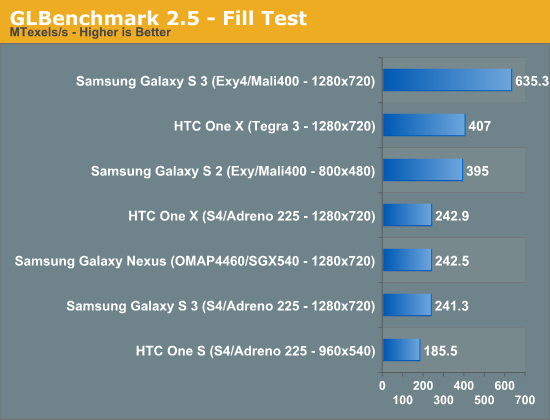
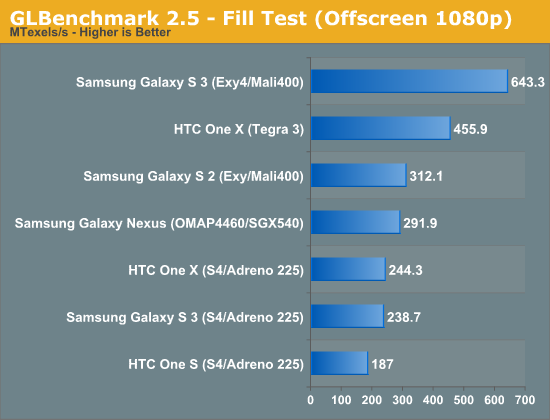
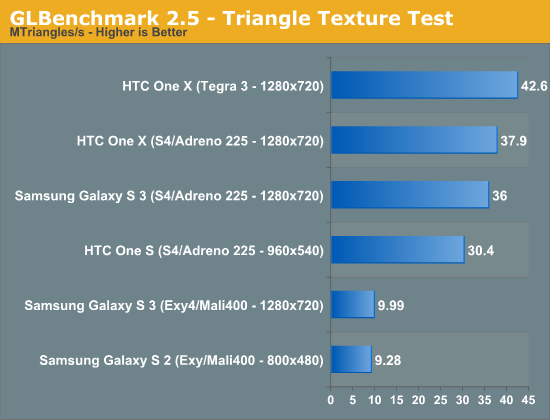
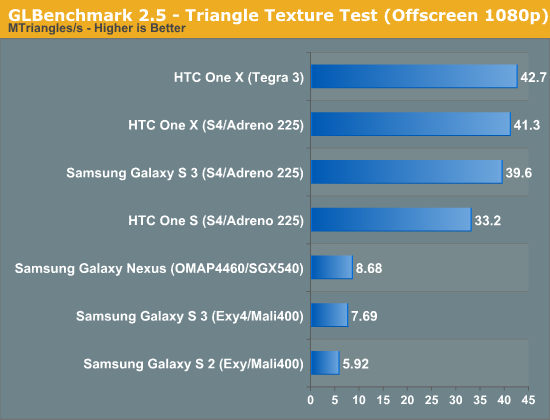
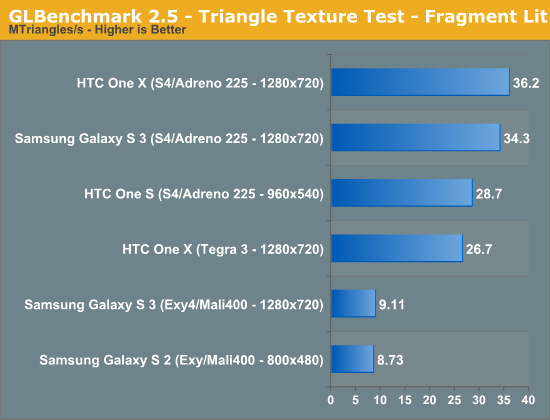
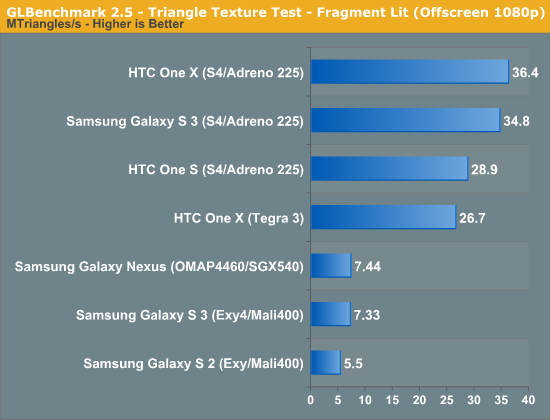
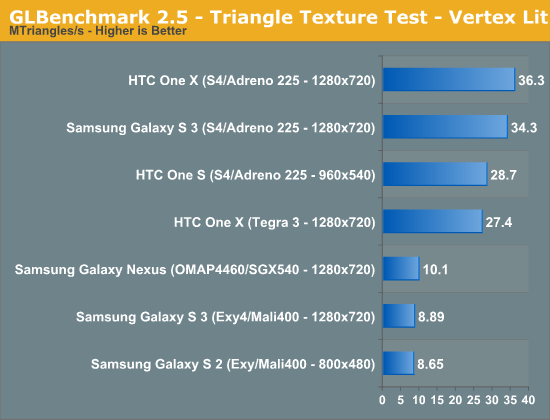

Egypt HD doesn't look quite as bad in the smartphone results, but that's mostly because we have some resolutions at 960 x 540 or below. Even then, none of these devices can break 30 fps. Remove vsync and crank up the resolution to 1080p and we hit the same ~13 fps cap as we did on the tablets.


The classic results once again show us that for lighter workloads, all of the modern GPUs (Mali 400, Adreno 225, Tegra 3) are sufficient. At lower polygon counts, even the latest Mali 400 can hit nearly 60 fps at 1080p.
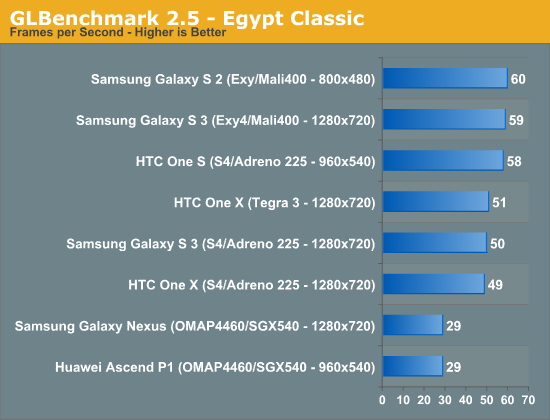
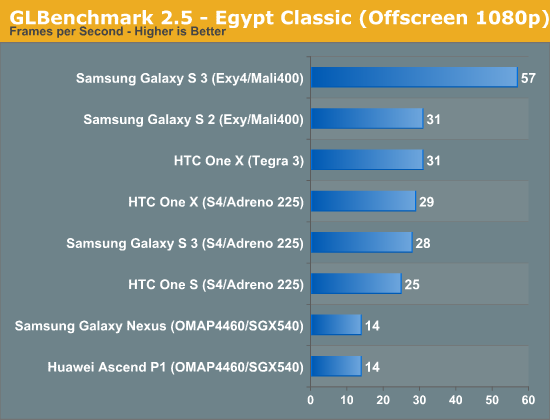










47 Comments
View All Comments
Stormkroe - Tuesday, July 31, 2012 - link
Performance improvements have caused vsync to get in the way of glbenchmark 2.1 numbers on the Galaxy S2Galaxy S2
Egypt HD 23.4fps
Egypt HD 720p offscreen 21.7fps
384k vs 921k pixels 240% workload, still 93% score
Galaxy Note
glbenchmark 2.1
Egypt High (1280x800) 48.1FPS
Egypt Offscreen (1280x720) 72.3FPS!!
1024k vs 921k pixels 90% workload, 150% score (newer scores, while too high, are no longer double, my bad)
Galaxy Note
GLbenchmark 2.5
Egypt HD (1280x800) 16.5FPS
Egypt HD (1920x1080) 15.9FPS
1024k vs 2073.6k Pixels 202.5% workload, still 96.4% score
Galaxy S3
Egypt HD (1280x720) 23.9FPS
Egypt HD (1920x1080) 23.7FPS
921k vs 2073.6k Pixels 225% workload, still 99% score
The GS2 and GS3 continue the trend of scoring almost the same while more than doubling the workload (only difference being the doubled workload is offscreen)
I included the galaxy note because it's native screen resolution of 1280x800 is very, very close to the offscreen resolution in GLbenchmark 2.1, making apples to apples very straightforward and eliminating vertex shader architecture as the culprit.
I got these scores from glbenchmark's site to give you as much detail as I could on short notice, it confirms the trend that shows in the AT reviews.
Hopefully this helps :)
metafor - Tuesday, July 31, 2012 - link
"I included the galaxy note because it's native screen resolution of 1280x800 is very, very close to the offscreen resolution in GLbenchmark 2.1, making apples to apples very straightforward and eliminating vertex shader architecture as the culprit."What's the line of reasoning here? Vertex or front-end limitations are fairly resolution independent (not entirely independent depending on the scene). And more importantly, GLB 2.1 didn't necessarily have the complex shaders to bottleneck Mali400.
The only time performance doubled when going offscreen is when the framerate hits the vsync limit during the on-screen test (GS2 in GLB 2.1).
Stormkroe - Tuesday, July 31, 2012 - link
You said the inconsistency could be because of a vertex shader weakness in Mali400.The reasoning behind listing the GL2.1 galaxy note scores is that we have a perfect example of NOTHING changing but the state of 'offscreen rendered' vs 'onscreen rendered', yet offscreen scores jump to 150% of onscreen scores. (I apologized for the lack of score doubling in my last post, as the numbers have become more even since I posted about this many months ago.
So, in a nutshell, Exynos score jumps to 150% by simply switching from onscreen to offscreen, with NO OTHER VARIABLES.
No that GL2.5 defaults to 1080p for offscreen, I've got no other way to compare on/offscreen evenly.
If you know of an exynos tablet with a 1080p res, we can do a straight apples to apples comparison with gl2.5, which judging by the gs2/3/note scores, will be a repeat of skyrocketing offscreen.
leexgx - Tuesday, July 31, 2012 - link
come one we do not want this comment box getting very small do wemetafor - Wednesday, August 1, 2012 - link
"The reasoning behind listing the GL2.1 galaxy note scores is that we have a perfect example of NOTHING changing but the state of 'offscreen rendered' vs 'onscreen rendered', yet offscreen scores jump to 150% of onscreen scores. (I apologized for the lack of score doubling in my last post, as the numbers have become more even since I posted about this many months ago.So, in a nutshell, Exynos score jumps to 150% by simply switching from onscreen to offscreen, with NO OTHER VARIABLES."
Erm, vsync. Like I said, when numbers come close to 60fps, the averages will vary a lot since the on-screen numbers will clip during high framerate times. That should be quite obvious....
edlee - Tuesday, July 31, 2012 - link
umm, how come there are a bunch of soc's missing from the test??Exynos + Mali 400
Qualcom + Adreno 220
Stormkroe - Tuesday, July 31, 2012 - link
It's all on the second page, except adreno 220 hasnt ever got a fix for 2.1 to run the offscreen game benches. Not sure if it works yet on 2.5.A5 - Tuesday, July 31, 2012 - link
I'm running it on my Adreno-220 EVO 3D right now. Will post in a second.A5 - Tuesday, July 31, 2012 - link
It looks like it falls in somewhere around 2/3rds of the Adreno 225's performance. They actually have a pretty decent comparison tool on the glbenchmark.com site.Stormkroe - Tuesday, July 31, 2012 - link
That's the same phone I have. Good to hear that it's finally working. Do you have the updated you drivers in your phone? They make an enormous difference for games. I'd be interested in your scores.